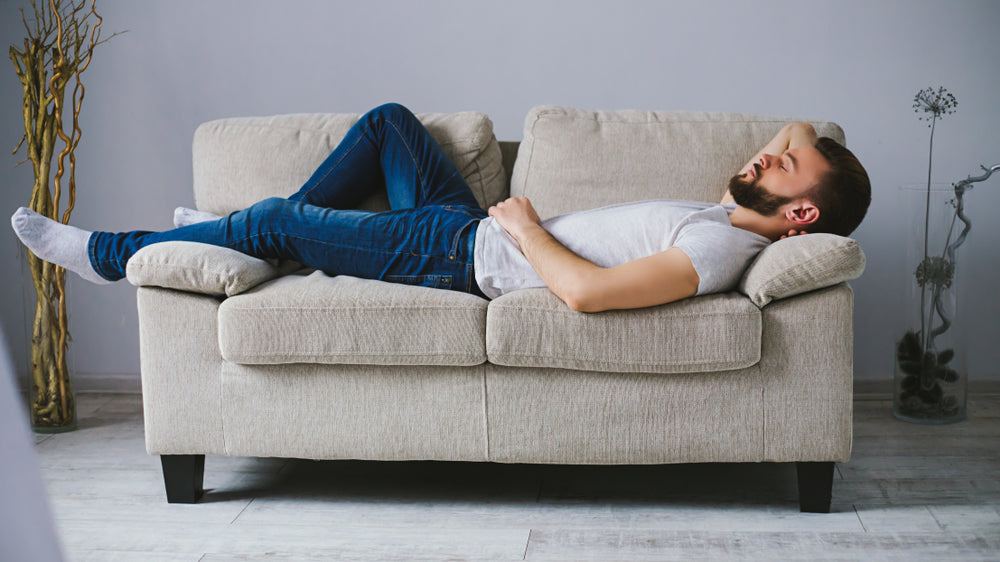Free U.S. Shipping On Orders Over $150

The Benefits of Napping: Powering Up Your Day with a Quick Snooze
Posted on
If, like me, you are well experienced in the art of napping, you know there is a fine balance between a quick power nap and a full on snooze.
While a snooze longer than 30 minutes can leave you feeling groggy, a 20-minute power nap feels like you’ve just had a solid eight hours of sleep. It energizes you and gives you an alertness that even coffee can’t match.
So why is a nap so magical? I explain the science behind napping in this article, the benefits of taking a power nap in the middle of your workday and how to nap like a pro.
How A Power Nap Works
If the world was perfect and we all slept 7-9 hours a day, there wouldn’t be any need for power naps for most of us. Unfortunately, sleep deprivation has become something of a modern life pandemic.
So we often find ourselves getting drowsy in the afternoon. If you are lucky to be in an environment where you can take a nap, it can help you tackle the rest of the day without fighting sleepiness and fatigue.
A power nap gives your body a fast-acting dose of energy, making it easier to power through the rest of the day. It also refreshes your brain, which helps with memory, creativity, mood and alertness.
As long as you sleep during the early to mid afternoon hours, napping will likely not interfere with your nighttime sleep.
Benefits of Napping
I wasn’t kidding when I said that coffee cannot match the rejuvenating power of a nap. There’s actually a study that shows this is true. Instead of grabbing yet another cup of coffee to try and stay alert, get that nap. Here are all the benefits you’ll enjoy.
- You’ll feel more energetic for the rest of the afternoon. A nap is great for getting rid of that common afternoon sluggishness.
- A nap is the best way to deal with sleep deprivation. If you didn’t get enough sleep last night, plan to take a nap early in the afternoon. It will help get rid of that headache, fatigue and other symptoms of sleep deprivation.
- A power nap will energize and refresh your mind. This is especially helpful if your work involves a lot of mental work or creativity. It also improves short term memory. Tip: if you want an even bigger boost of creativity, take a longer 60-90 minute nap. That is, if you have the time for one.
- Another brain-boosting benefit of napping is improved focus and concentration. Whether you are filling out paperwork, writing those reports or attending an afternoon lecture, a nap will help you stay alert.
- If you are feeling a bit cranky, it’s probably because you’ve not slept enough. Napping works wonders at lifting your moods. You could also just be hungry, so have a bite as well.
- Naps are not just for office workers. For those who drive or operate machinery, napping makes your work a lot safer. It improves your concentration and reduces your reaction time. A quick 20 minute nap could very well save your job, and your life.
Short vs. Long Naps: Which One Works Best?
There’s an art, more like a science, to timing your naps. It’s based on our natural sleep cycles.
When you fall asleep, you immediately get into stage 1 sleep that lasts for about 7 minutes then stage 2 sleep that lasts 10-25 minutes.
The most common nap is a short 20-30 minute nap that encompasses both stage 1 and stage 2 sleep. This type of nap gives you a quick physical and mental boost that lasts for a few hours.
Because you’ve not yet gone into deep sleep, a short nap also prevents sleep inertia, which is that groggy feeling you get if you nap too long.
The biggest advantage of short naps is that they are convenient for most people. Most of us cannot afford to snooze for more than half an hour.
A long nap is any nap that lasts beyond 30 minutes. This is where you might wake up with your head filled with cobwebs if you are not careful with your timing.
Once you sleep past 30 minutes, your body goes into stage 3 deep sleep. Interrupting this stage is what causes sleep inertia. You can avoid it by sleeping for 90 minutes. This coincides with the end of stage 3 sleep, so you are not interrupting anything. You’ll still feel a bit groggy, but it fades quickly.
You can also try a 1-hour nap. The sleep inertia will last for longer, but you’ll feel much more refreshed later.
Take a short nap if you don't have a lot of time or you are only a little tired. Take a long nap if you have more time, you are feeling very tired, or you have severe sleep deprivation.
A long nap is also the best choice if you want a bigger boost in creativity and mental alertness.
How to Nap Like A Pro
I recommend planning your nap earlier in the day, ideally around or immediately after lunch. Taking a nap too late in the day (after 4pm) can interfere with your nighttime sleep.
Decide how long you want to sleep and set an alarm to wake you. Then find a quiet and relatively comfortable place to nap. Consider keeping a sleep mask nearby; it’ll help you fall asleep faster.
Once you wake up, a quick splash of water on your face, some time outside or a cup of coffee works great for getting rid of any sleep inertia you might experience.
Happy napping!
Quick links
Contact
6063 Hudson Road #160
Woodbury, MN 55125
Yo@hercLeon.com
Leave a comment: